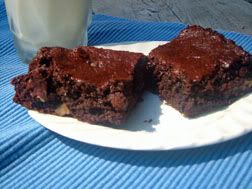Bryanna Clark Grogan’s Vegan Feast Kitchen/ 21st Century Table: The kitchen journal of a vegan food writer.. I'm on Facebook and Twitter (see links in sidebar at right).
Tuesday, August 29, 2006
5 FOODS YOU HAVE TO EAT BEFORE YOU DIE, AND HOW TO MAKE HOMEMADE PITA BREAD

SusanV over at http://blog.fatfreevegan.com/ "tagged" me for this "non-meme". She wrote: "The idea is to create a list of food bloggers' top picks for things you've eaten and think that everyone should eat at least once before they die." It comes from Melissa at The Traveler's Lunchbox.
It was tough to choose, so I just decided to go with what came to mind first:
1.) homemade crusty sourdough bread
2.) Denman Island Chocolate, especially the hazelnut variety
3.) a sandwich made with homemade white bread, (vegan) mayonnaise, a ripe tomato still warm from the garden (it HAS to be freshly-picked from a garden and NOT the hothouse variety), and a little salt
4.) homemade ravioli with porcini mushroom filling
5.) hot homemade cornbread with vegan butter (try my homemade palm oil-free Buttah) and blackberries you just picked
NOW, ABOUT THAT PITA BREAD.....
I hadn't made homemade pita for some time, but yesterday I decided to try it in my new oven because I needed some for a recipe I was trying out for the newsletter. As you can see from the picture above, it worked beautifully! It's really very easy to make and better than any you can buy. You need a pizza stone or a cast iron skillet or griddle (at least 10-inch) or some unglazed tiles (you can buy slightly chipped ones at a tile store very cheaply) and a good hot oven.
The pitas (which are pretty large) are cooked one at a time, unless you have enough unglazed tiles to cover a whole oven rack, in which case you can do 2 at a time. But they take only 3 minutes to cook, so, even though you have to be there during the whole baking time, it goes fast.
Printable Recipe
BRYANNA'S HALF-WHOLEWHEAT PITA BREAD
makes 8/ 9" pitas
2 1/2 cups warm water
2 tsp. dry active baking yeast (or 1 1/2 tsp. instant yeast)
3 cups wholewheat bread flour
1 T. salt
1 T. olive oil
3 cups unbleached white flour
Dissolve the yeast in the water. Add the whole wheat flour and mix briefly. Let this "sponge" stand for about 30 minutes. Add the salt, oil and unbleached flour, and knead for about 8-10 minutes. Don't add too much flour-- the dough should be silky smooth and not tough. You can knead the dough with a little oil instead of with flour if necessary to keep it from being too dry.
Place the dough in an oiled bowl, oil the top, cover, and let stand in a warmish place until doubled in bulk, about 1 1/2 hours. Punch it down and divide into 8 equal pieces on a floured counter. Keep the balls of dough covered when you aren't working with them.
Roll each piece out on a floured surface with a rolling pin to about 9" in diameter (they don't have to be perfectly round). For maximum "puff", try to avoid stretching the dough. I just roll out from the center toward the outer edge, turn the dough a quarter-turn and repeat, doing this until it is the right size. The thickness should be even all over. You'll get the hang of this after a while and it will go very fast.
Keep the rolled-out pita on a floured counter or floured cookie sheets and cover them.
Preheat the oven to 500 degrees F., with your unglazed tiles or pizza stone or cast iron pan or griddle on the rack at the lowest position (remove other racks).
My old method of transferring the pita to the hot surface was to place the pita to be cooked on a well-floured cookie sheet, pull the rack out as far as it will go and just flip the cookie sheet over to upend the pita onto whatever hot surface you are using. (If it lands with a wrinkle or two, just quickly straighten it out and shut the oven door.) If you are deft, you can just slap it onto the hot surface with your hand! Now I use a well-floured small baker's peel or cake and pizza lifter or even large bench scraper.
When the oven is up to temperature, place a pita bread (or 2, depending on how much room you have on the tiles/stone) on the hot surface, as directed above, quickly shut the door, and set the timer for 3 minutes.
Turn on the oven light and watch it puff up before your very eyes! (At first, your efforts may not puff perfectly, but you'll get the hang of it! You can still use them even if they don't puff.)
When the timer "dings", take the pita out carefully (use a large bench scraper or small baker's peel to take it out (or check out this nifty inexpensive cake and pizza lifter), and either place the hot pita bread (which will deflate immediately) in a large open paper bag, or wrap loosely in a clean large tea towel. Stack them up as you go. The pita should not get brown or crispy! You want them to stay flexible and soft.
That's it! Eat them within a day or so (place in plastic bags after they cool thoroughly) or freeze them. If they have puffed properly, when you cut them in half, they will have a "pocket".
Another way to enjoy them is as "Zatar bread":
Brush the bread with a little olive oil and sprinkle with the zatar, a delicious Lebanese spice mixture of lemony-tasting reddish sumac, sesame, thyme and sometimes other herbs.
See this post of mine on za'atar.
Enjoy!

Sunday, August 27, 2006
EATING VEGAN BROWNIES ON A BOAT TRIP AROUND DENMAN ISLAND

The brownies in question, my "Almost-No-Fat Brownies" (but with walnuts added), recipe below.
Yesterday afternoon Brian and I went on a trip with my son Tim, his wife and their three girls, on their little boat around Denman Island, where we live. It was a glorious day and we had a great time. Best of all, was seeing our home island from a different perspective, seeing the mountains on both sides of us,

seeing houses on Denman that you can't see from the roads, and seeing porpoises and seals right alongside the boat! I took some inari sushi made with brown rice and quinoa (an interesting if inadvertant Peruvian/Japanese fusion, I just realized-- Peru has a large Japanese population, which has influenced the cuisine), and some almost-no-fat brownies for munching.
NOTE: I forgot to bring my digital camera with me on this trip! So, the scenic pics are variously from government and local tourism sites, or taken by me or my friends Fireweed, and Debbie Knight, previously.
We embarked on our little journey at the boat launch near Boyle Point Park, which the locals call "Eagle Rock":

We headed across to Ford's Cove Marina on Hornby Island (my oldest daughter lives on Hornby with her husband and two teenagers. It's a quaint little spot with some beautiful homes and a funky, well-stocked grocery store (shown here) and art shop. (The store carries soy cheese and fresh tofu, soy ice cream and fruit sorbet, and lots of Asian condiments.)
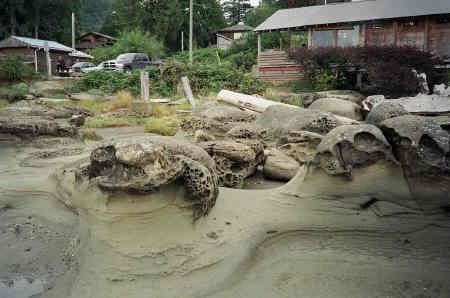
Here's a view from a Hornby beach:

and a view of Denman from Hornby:

After getting a few necessaries, we headed back across and up the eastern side of Denman to "Tree Island" (actually "Sandy Island Provincial Marine Park", but everybody calls it "tree island"). We had porpoises swimming near the boat on the way there.
You can actually walk there at low tide, but it's a long way and people have got stuck there! we spent a couple of lazy hours on the sandy beach there, taking in the sun (there was a nice cool breeze to mitigate that), and watching the girls cavort in the water.

Then we all piled into the boat again and went back to the boat launch up the western side of Denman, enjoying the cool wind and admiring the houses along the shore, which we never see from the land. The two younger girls fell asleep on the way.

Here's the ferry dock on the west side of Denman:

and a view of Denman from the ferry dock on the Vancouver Island side at Buckley Bay:

and a Denman Island beach scene:

We drifted for a bit near Chrome Island Lighthouse

where we saw a seal feasting on the school of tiny fish that were jumping in the water all around us-- it looked and sounded as if it was raining! We docked the boat and went home feeling very relaxed.
Once home, we had a very simple supper of rosemary-roasted Yukon Gold potatoes and steamed asparagus with mushrooms in a simple sherry sauce:
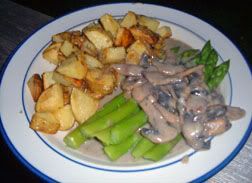
Now, those brownies:
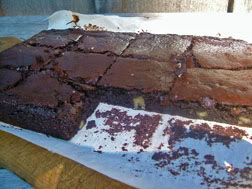
Printable Recipe
BRYANNA'S ALMOST NO-FAT BROWNIES(Can be GF)
(From my second cookbook, The Almost-No-Fat HOLIDAY Cookbook.)
Nutrition facts include 1/2 cup chopped walnuts. If you need a big batch of brownies, triple the recipe and use one whole 12.3 oz. box of extra-firm (regular or lite) SILKEN tofu.
1 cup brown sugar
4 oz (1/2 c.) medium-firm tofu OR firm or extra-firm SILKEN tofu
1/2 cup unsweetened organic cocoa (I use Dutch-process-- read about cocoa powders here)
1/3 cup flour OR GF flour mix
1/4 cup water (can be part liqueur of choice, such as Kahlua)
4 tsp powdered Ener-G or Orgran No-Egg egg replacer powder
1 Tbs coffee (or coffee substitute) granules or espresso powder
2-3 tsp pure vanilla extract
1 1/2 tsp vinegar
1/2 tsp salt
1/2 tsp baking powder
1/2 tsp baking soda
OPTIONAL: 1/4-1/2 c. chopped nuts
Preheat the oven to 350 degrees F. In the food processor mix until smooth the sugar, tofu, cocoa, water, egg replacer, coffee granules, vanilla and vinegar.
In a medium bowl whisk together the flour, salt, baking powder and soda. Add the cocoa mixture and mix briefly. Add nuts, if using.
Pour the mixture into a 7 x 11" or 8 x 8" cake pan lined with cooking parchment. Spread evenly. Bake 25 minutes. Cool on a rack in the pan, then cut into bars.
Servings: 12
Nutrition Facts
Nutrition (per 1/12th): 131.7 calories; 22% calories from fat; 3.8g total fat; 0.0mg cholesterol; 148.4mg sodium; 159.5mg potassium; 24.4g carbohydrates; 1.6g fiber; 18.0g sugar; 22.7g net carbs; 2.5g protein; 2.6 points.
Enjoy!

Friday, August 25, 2006
LEBANESE LENTILS AND PASTA

After the excess of last week's blog entry, here is my take on a simple, healthful, delicious Lebanese dish that is one of our favorite go-to quick meals-- plus a delightful Lebanese iced tea recipe from an old friend. In the Middle East, pasta is often added to sauce-y dish in its dry form, which saves a step, and washing a pot, and thickens the sauce. This is a great example of that technique, and it works well with whole wheat pasta. The greens in the dish are not traditional, but they are often added to Lebanese lentil soups, so I decided to add some and we prefer it that way now.
Printable Recipe
BRYANNA'S LEBANESE STYLE LENTILS AND PASTA
Serves 3-4
This is a delicious Lebanese dish. It makes a full meal (the greens aren't traditional, but I like them).
1 cup brown lentils, rinsed
5 cups vegetarian broth
2 medium onions, chopped
2 cloves garlic, chopped
1 teaspoon ground cumin
2-4 cups chopped raw chard, kale or, other greens, or 1/ 10 ounce package chopped spinach, thawed and squeezed dry
4 ounces spaghettini, broken into 4" long pieces (whole wheat pasta is good in this dish)
1/4 cup chopped parsley or cilantro (optional)
1 pinch cayenne pepper
2 tablespoons lemon juice OR 1 tablespoon sumac (see about the herb sumac here)
salt and freshly-ground black pepper to taste
In a medium saucepan, bring the broth and lentils to a boil . Turn down to low, cover and cook for about 25 minutes, or until the lentils are tender but still holding their shape. (OR, pressure cook for 15 minutes.)
Steam-fry the onion, garlic, and cumin in a large nonstick pot sprayed with oil from a pump sprayer, or with cooking spray, until soft. OR place in a covered microwavable dish or casserole (such as Pyrex) and microwave at full power for 7 minutes. PS: if you don't mind a little fat, saute in a bit of olive oil instead.
Pour the lentils and all of the broth with the onion mixture into a nonstick wok or deep skillet. Add the greens, broken pasta, optional parsley or cilantro, if using, and the cayenne. Bring to a boil, then turn the heat down to medium.
Cook, uncovered, over medium heat for about 10 minutes, or until the pasta is tender and most of the broth has been absorbed, leaving a sort of sauce. Add the lemon juice or sumac and mix well. Taste for salt and pepper.
Serve hot.
********************************************
Printable Recipe
EASTERN TEA FOR DANCERS
(Given to me by my friend Lee Hoffman of New Orleans. She tasted this in a Lebanese restaurant and thought my bellydancer friends and I would enjoy it, which we do! This is her "voice" describing the recipe.)
Description:
A tangy iced tea that tastes like you've left the continent and arrived in an exotic place. I had some in a middle Eastern restaurant, but couldn't duplicate it until I got hold of the pomengranate molasses.
Ingredients:
4 tea bags or caffeine-free tea bags
4 C. boiling water
Make tea as usual.
Add 2-3 T. pomegranate molasses (see below)
Sugar to taste. Serve over ice.
Add 1 tsp. rose water on the top. Don't stir.
Sprinkle on about a tablespoon of pine nuts (raw). Why? I don't know, but it was served that way in the restaurant.
ROSEWATER = rose water = ma ward
Notes: This is distilled from rose petals, and used in the Middle East, North Africa, and India to flavor desserts. Don't confuse this with rose essence, which is more concentrated.
ABOUT POMEGRANATE MOLASSES (known as nasrahab in Georgian and dibs rumman in Arabic) is an essential Middle Eastern ingredient. It has a wonderful flavor and heady aroma, and keeps in the refrigerator after opening almost indefinitely. The Iranian kind tends to be sweeter and thinner than the Lebanese brands.
The uses for this thick, tangy, piquant syrup are many. It blends well with walnuts, adds a tart and pungent flavor to beans and other savory dishes, and gives an astringent edge to salads and vegetables. It is delicious in glazes and marinades and it can even be diluted and used for sharp drinks and tart sorbets.
This should not be confused with grenadine syrup, which is made from the same base but has sugar and other other flavorings added.
Both rosewater and pomegranate molasses are available from amazon and from Middle Eastern, Greek and Persian grocery stores, and gourmet food stores; rosewater is also available from Indian grocery stores.
Enjoy!
Monday, August 14, 2006
MEDITERRANEAN SOURDOUGH BREAD WITH SOY CAPPUCCINO
 I haven't blogged for over a week! Summer kinda got away with me (not to mention a whole passle of little grandaughters!). Nothing earthshaking today, but I wanted to show you this yummy soy cappuccino (made with homemade soymilk) with chocolate shavings that made a great Continental-style breakfast with the following (partly wholewheat) bread:
I haven't blogged for over a week! Summer kinda got away with me (not to mention a whole passle of little grandaughters!). Nothing earthshaking today, but I wanted to show you this yummy soy cappuccino (made with homemade soymilk) with chocolate shavings that made a great Continental-style breakfast with the following (partly wholewheat) bread:
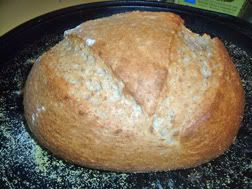
Sourdough Olive Oil Bread
ABOUT THE BREAD:
I know, it's summer-- who bakes bread? Well, I had some extra fresh sourdough starter that I wanted to use-- exactly enough for this loaf. And I got a new stove and wanted to test out the oven. The recipe I used (see below) is actually a bread machine recipe
To bake it in the oven, I used the dough cycle, and then formed the dough into a ball on a greased and cornmeal-dusted pizza pan and let it rise for about 45 minutes, well-covered. I heated the oven (with convection) to 400 degrees F. I slashed the loaf with a razor blade and misted it with water before placing in the oven. NOTE: For an extra-crunchy crust and bigger holes in the crumb, you can bake this in a heavy covered pot, like a mini-brick-oven, if you like. See instructions here.

I baked it for about 10 minutes, sprayed it again, baked another 5 minutes, lowered the heat to 375 degrees F and baked about 15 minutes more. (Do the knock-on-the-bottom-and-listen-for-the-hollow-sound test.) Without convection, you should lower the heat about 25 degrees and cook a bit longer.
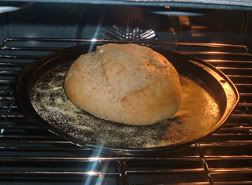
The crust was nice and evenly-golden and crisp, and the inside moist, with a pronounced sourdough flavor, despite the yeast (the addition of yeast tempers the tangy sourdough flavor, but this bread has a goodly amount of fresh sourdough starter in it). Try to resist cutting it right away-- it actually finishes the cooking process at it cools.
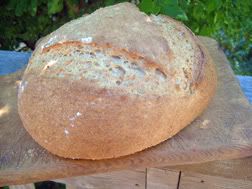
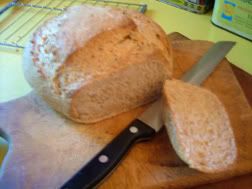
NOTE: If you are unfamiliar with sourdough, see http://veganfeastkitchen.blogspot.com/2006/04/1906-earthquake-in-sf-my-grandfather.html My San Francisco starter, how to make it vegan and how to use and care for it is at that link. I actually have two vegan sourdough starters-- both are very reliable. I also use the "Oregon Trail Sourdough Starter", which I treat the same way. You can get a free (dried) starter (and it's a great story that goes with it!) here. You just pay postage. (PS: I don't use the sugar and potato they call for in the instructions., and it works fine.)
If you would like a longer version of all this info, with recipes, write to me via my contact page.
Printable Recipe
BRYANNA’S ABM SOURDOUGH ITALIAN OLIVE OIL BREAD
Makes a 1 1/4 lb. loaf
A pretty fast recipe made with sourdough starter and yeast.
1 1/2 c. fresh sourdough starter (less than 2 weeks old if stored in the refrigerator) (See Note above)
1 T. water (hot if the starter is cold)
3 T. olive oil
1/2 T. salt
2 tsp. sugar
1 cup wholewheat flour (or wholewheat bread flour in the USA-- Canadian flour is higher in gluten)
1/2 cup unbleached white flour (or white bread flour in the USA)
1/4 c. bran
1 tsp. dry active baking yeast
Mix the ingredients in your bread machine
Check the dough during the first knead to make sure that it is neither too dry, not too wet. If it’s too dry, add water by the tablespoonful, letting it knead in, until it looks right. If it’s too wet, do the same with flour. This should be a moist dough, but it should come together in a ball.
See instructions above for how to bake the bread in the oven.
If you want a more attractive top crust to the ABM bread, 5 minutes before the bread is due to bake (I set my kitchen timer to remind me of this), you can make a decorative slash in the top of the bread with a razor blade, and you can also glaze the bread with some soymilk, using a pastry brush, or sprinkle the top with flour.
Cover the “window” in the top of your machine with foil, so that the top of the bread will brown properly. Remove the bread immediately from the machine when done, placing on a rack to cool thoroughly. This will insure a crisp crust.
Photo of the bread machine version:
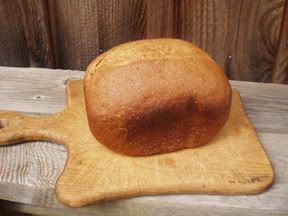
Enjoy!

Labels:
bread,
cappuccino,
crusty bread,
sourdough,
sourdough bread,
soy cappuccino
Friday, August 4, 2006
EAT YOUR SUMMER VEGGIES IN A FAT-FREE CREAMY SOUP

This recipe is almost all veggies. As the "creme", I use a base of broth, onions, garlic (lots of garlic, but-- really-- it mellows out and just adds complexity to the flavor), and either cauliflower or peeled zucchini (or other summer squash), cooked very soft and then pureed. Then I add more vegetables, finely-chopped and cooked in broth, along with some herbs.
It sounds too simple to be good, but it is really delicious. I'm eating some as I type, made with a cauliflower base, and a little cabbage, a head of broccoli, some carrots, and some rapini, and flavored with dillweed.
Printable Recipe
BRYANNA'S FAT-FREE VEGETABLE CREME SOUP DU JOUR
Serves 4
Cooked pureed cauliflower or peeled summer squash makes this soup creamy, without potatoes, dairy or vegan milks or creams, or nuts.
1 large onion, minced (you could use leek or green onion instead, if you prefer)
4 cups vegetarian broth
1/2 medium head cauliflower, trimmed, then chopped
OR 1 lb. zucchini or other summer squash, PEELED and chopped
1 head garlic, separated and peeled (or about 12 cloves roasted garlic from a jar)
(Trust me-- this mellows out and adds flavor, but doesn't taste garlicky.)
7 cups finely-chopped raw vegetables of choice (see options below)
1 teaspoon dried dill weed, basil, oregano, or summer savory (or 1 tablespoon fresh, chopped), or curry powder
salt and freshly-ground black pepper to taste
Optional:
1 tablespoon vegan bacon bits
1 more cup of vegetarian broth if it's too thick for your taste
Add the onion to a medium pot with 1 cup of the broth and the cauliflower OR peeled summer squash. Add the raw garlic cloves, if using (if you used roasted garlic, add it later.) Cook, covered, over medium heat until the vegetables are very tender.
OR you can cook the mixture in a microwave-safe dish in the microwave, covered, for 6 minutes.
Now, add the roasted garlic, if that's what you are using instead of raw garlic. Puree the onion/broth/cauliflower or squash mixture in a food processor
Meanwhile, bring the remaining 3 cups of broth to a boil in a large pot and add the chopped vegetables of your choice. Simmer, covered, until just tender, but still holding their color. If you didn't chop them finely enough, you can use a hand immersion blender to chop them up a bit more, but you want some texture.
Add the pureed mixture from the food processor. If the soup looks too thick after stirring together, add the last, optional, cup of broth. Taste for salt and pepper, and add your herb or spice of choice, and the optional soy bacon chips, if you like. Simmer a few minutes, just to mix the flavors, then serve.
Vegetable Options:
You can use any low-starch vegetable, really, but you might prefer to stick to the same color of veggies if using a mixture, just for the sake of aesthetics-- for instance, kale and broccoli together. (I didn't do that this time-- I added carrots to the green mixture-- but it still looked nice, I think.)
Other veggies you could consider are; carrots; chard, spinach, or other greens; green beans; asparagus; any kind of UN-peeled summer squash (if using cauliflower as the "cream" base); or cauliflower (if using peeled summer squash as the "cream" base); cabbage (savoy would be good); Brussels sprouts; celery or fennel (as part of a mixture-- the flavor would be too overwhelming if you used only these); tomatoes; etc.. So, you could mix carrots and tomatoes, maybe with some celery or fennel; or yellow summer squash and yellow beans; or any of the green veggies together.
Nutrition (per serving): 88.3 calories; 9% calories from fat; 1.0g total fat; 0.0mg cholesterol; 88.7mg sodium; 750.9mg potassium; 17.1g carbohydrates; 2.8g fiber; 3.1g sugar; 14.4g net carbs; 6.6g protein; 1.3 points.
Enjoy!
Labels:
creamy vegetable soup,
fat-free,
fat-free soup,
soup,
vegetable soup,
vegetables
Tuesday, August 1, 2006
A MOTHERHOOD ISSUE?

I like to make hearty salads in the summer, based on potatoes, whole grains, pasta, and/or beans, and have them on hand for quick and cool dinners. I make them in the cool of the morning, and the flavors meld and intensify in the refrigerator over the next few days. Sometimes we have several such salads on hand and can make a lovely summer salad plate.
For grain salads, I’ve been using not only the usual rice and bulgur, but quinoa, barley, and whole grain kernels (or “berries”) such as wheat, rye, and spelt, especially since I've been on the Weight Watchers' Core Food Plan, which emphasizes whole grains-- and I mean whole, rather than ground into flour. These salads have proven to be delicious, chewy, filling, and nutritious, like the recipe below, which I promised to post.
But there’s a whole movement against grain out there. It’s the latest trend. The author of the "No-Grain Diet" is the same person who claims that the coconut oil he sells on his site will: "Reduce the risk of heart disease; Lower your cholesterol; improve conditions in those with diabetes and chronic fatigue; Improve Crohn's, IBS [Irritable Bowel Syndrome], and other digestive disorders; Prevent other disease and routine illness with its powerful antibacterial, antiviral and antifungal agents; and (my favorite!) "The fatty acids in coconut oil can kill herpes and Epstein Barr viruses …. They kill Candida and giardia. They kill a variety of other infectious organisms, any of which could cause chronic fatigue." (UPDATE: you now have to register on his site in order to read the articles.)
Mercola serves on the board of directors of one of the most anti-vegetarian organizations on the planet, the Weston A. Price Foundation. On his diet regime you are supposed to eat no grains (except a little bit of sprouted grain cereal), on the theory that whole grains contain too many phytates which will block absorption of minerals, a theory easily disproved), no sugars, no simple starches (potatoes, carrots, etc.), certain fruits only, most vegetables unless very starchy, meats, fish and poultry (organic and preferably "wild")- preferably organic, butter, cream and cheese; and he barely mentions exercise!
On the strict version of the Mercola diet, you are also to avoid beans; on less strict versions you can have some, but you must add other proteins! He writes: "If you have high insulin levels, you will want to avoid beans until you have normal insulin levels." Just the opposite of the results Dr. Neal Barnard's clinical study on diabetes and diet. (Check out his book on reversing diabetes-- I did the recipes for it. Beans were #1 on the list of foods to use!) Dr. Barnard is the president of the Physicians Committee for Responsible Medicine-- check out their diabetes resources.
Here's a review of the "No-Grain Diet" on amazon which I think is very to-the-point:
"We all agree that refined grains are not health foods, so the only question pertains to whole grains. But Mercola doesn't address it. Yes, there is an epidemic of heart disease, obesity, and diabetes, but it certainly is not due to whole grains, because, for the most part, people are not eating them, and certainly not obese people. Mercola's case centers around insulin, and a train of havoc that follows from its release. However, in his rant ravings, Mercola makes a flying leap from what is, in fact, normal physiology (the metabolism of carbohydrate by the human body) to disease. The whole idea that I eat potato, or a bowl of brown rice, and therefore alarms go off inside my body, my blood sugar goes soaring out of control, and metabolic mayhem follows is pure fantasy. The burning of carbohydrate as fuel is as natural for a human being as breathing air (in fact, it's the main reason you need to breathe air). In the topsy-turvey world of Mercola, plain carrots are fattening. That's right, they raise your triglycerides and get deposited all over your body as fat. Haven't you noticed that among carrot eaters? But whole raw milk, with that rich, thick layer of cream on top, that's not fattening. Like other newsletter writers, Mercola picks and chooses articles from the medical literature which he thinks supports his position, while glibly ignoring the ones that contest it, like for instance the myriad of studies which show that increasing whole grains in the diet promotes slenderness, arterial health, and protection from diabetes. I am a 52 year old man. I am 5'6" and I weigh 135 pounds. My body fat percentage is very low. I eat a diet that is high in fruits, starchy vegetables, whole grains, and nuts. I eat practically no animal food of any kind. I am practically a total vegan. My blood cholesterol last checked was 150. My triglycerides were 35! (Normal triglyceride according to Medicine is supposedly 75 to 150) My blood sugar was 84. These results are totally in contrast to what Mercola's ideas would predict. And believe me, there is nothing special about me. It has nothing to do with me having some unique metabolic type or other fanciful notion from the mind of Mercola. I do not think that grains are as valuable as fruits and vegetables, nor do I think they should be given as much importance in the diet. Yet, leading nutritional doctors whom I respect (including Dean Ornish, John McDougall, Andrew Weil, Michael Klaper, Neil Barnard, and others) all believe there is a place for whole grains in a healthy diet. The Egyptian workers built the Pyramids on a grain-based diet. The Roman Army conquered the world on a grain-based diet. There are many causes of degenerative disease in modern life, but eating whole grains is not one of them." Ralph C. Cinque (Buda, Texas)
Then there's the argument that allergies to grain (especially wheat) are rampant, so we should all avoid them, just in case. Now, I understand that those with celiac sprue disease cannot eat anything with gluten, but they can still safely eat (according to celiac.com) rice, buckwheat, wild rice, corn, amaranth, quinoa, millet, teff, and Job's tears (and oats processed in a gluten-free facility). And I know that there are some people who are allergic or intolerant to grains, but that only affects a small percentage of the population (excluding celiacs, wheat allergy, for instance, is estimated at 0.5% of the population and wheat intolerance at 15% of the population).
Many people say they are “allergic” to wheat, but a true wheat allergy is very rare and can cause extreme reactions, such as anaphylaxis. What more likely is actually occurring is intolerance, which is the inability to digest wheat protein properly, and which can cause bloating, cramps, etc.. Grain intolerance is most common among young children, the majority of of whom will outgrow it within 5 years, especially if that grain is totally avoided for a time. (This happened with my oldest grandson, now 16 , who was intolerant to corn, but now is not and he eats tortilla chips regularly!) If either of these conditions applies, there are other grains than the one(s) you are allergic/intolerant to that will be perfectly fine for you.
Despite these facts, people keep buying these books (like the one mentioned above) claiming that you will lose weight AND cure all of your ills if you just stop eating grains! You WILL most likely lose weight because you’ll be cutting calories! But, if you aren't losing on Dr. Mercola's diet, guess what his advice is? You should go on a 1000 calorie a day diet...something only to be attempted by very, very petite, inactive women! (It's hard to get enough nutrients with less than 1200 calories a day.) Most of the people who bought those books in an effort to lose weight will be on some other diet a few months from now, no doubt.
Grains, primarily wheat, rice, and corn, have sustained mankind for 12,000 years, and allowed civilizations to flourish.
Let's not "throw the baby out with the bathwater". Instead of saying “no grain”, why not “whole grain”? You'll probably lose some weight, save some money, and have far less risk of diabetes, constipation, degenerative dieases, gallstones, and stroke. (See this article about wheat, for instance, and their entries on other grains.)
An interesting take on this comes from “The Second Seasonal Political Palate” by the Bloodroot Collective, a feminist vegetarian collective that runs a well-known restaurant in Bridgeport, Connecticut, and writes vegetarian cookbooks. (Quite interesting ones with very opinionated articles in them!. The books and restaurant are not vegan, but have vegan options.) “Grains have been associated with the earth’s abundance or what patronizing writers call fertility goddesses. Grains are our mothers. Demeter and wheat and the corn mother are but two examples. All over the earth, oldest images of both mother and food are personified in Goddesses of grain...Now the latest wrinkle is allergies to wheat, corn, and fermentation...We prefer to remember the value of grains, legumes (“that which is gathered”), fruits, whether fresh or fermented, yeasted, brewed, in all stages from seed to decay. These are what sustain us.”
Printable Recipe
BRYANNA’S AVOCADO, TOMATO AND WHOLE GRAIN SALAD
Serves 4
This was inspired by a recipe from the California Avocado Board. It’s suitable for the Weight Watcher’s Core Food Plan.
1 cup wheat kernels (sometimes referred to as “wheat berries”) ( OR you can use rye, spelt, or kamut kernels)
3 cups water
1/2 tsp dried thyme
1/2 tsp dried basil
1/2 tsp salt
4 sundried tomato halves (NOT IN OIL)
1 Tbs extra virgin olive oil
1 tsp balsamic vinegar
1 clove garlic, crushed
1/2 tsp salt
1 small red bell pepper, finely diced
1 small onion, chopped and covered with boiling water for 10 minutes, then drained (OR use raw chopped red, sweet, or green onion)
1 medium tomato, diced
1/4 cup fresh chopped herbs: parsley, basil, oregano, cilantro, etc.
1/2 large avocado, or 1 small peeled and pit removed, diced
Juice of 1 lemon (or 2 Tbs organic bottled)
Wash the wheat or other grain kernels. Add the water, dried herbs, 1/2 teaspoon salt, and the sundried tomatoes. Bring to a boil, then reduce heat to very low and simmer, covered, until tender. This can take from 1-2 hours. Alternately, pressure cook for 45 minutes.
Drain off any extra liquid (save to use in soup stock).
Place cooked kernels in a bowl. Chop the sundried tomato and add back to the cooked grain. Add the olive oil, vinegar, crushed garlic, and last 1/2 tsp. salt. Mix thoroughly. (Up to this point, the salad can be prepared ahead and held in the refrigerator for 1-2 days).
Add the red bell pepper, onion, and tomato. Toss and add the fresh herbs. Toss the diced avocado in the lemon juice. Add to the salad and mix in gently.
Nutrition (per serving, made with wheat): 242.4 calories; 28% calories from fat; 8.1g total fat; 0.0mg cholesterol; 522.0mg sodium; 542.4mg potassium; 40.7g carbohydrates; 8.8g fiber; 4.2g sugar; 31.9g net carbs; 6.3g protein; 4.7 points.
Enjoy!

Subscribe to:
Posts (Atom)




